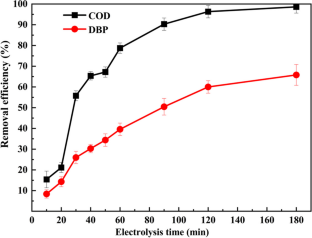Water, Air, & Soil Pollution ( IF 2.9 ) Pub Date : 2024-04-19 , DOI: 10.1007/s11270-024-07051-2 Dexiang Liao , Fan Wu , Tianyu Deng , Fang Yin , Penghao Su , Daolun Feng

|
This study aims to solve the discharge of printing and dyeing reverse osmosis concentrate (PDROC) from a local printing and dyeing factory in Hangzhou, China. Electrochemical technique was used to treat the organic content of the concentrated wastewater. At the same time, the concentration levels of the target chemical species were double-checked using liquid–liquid extraction-gas chromatography–mass spectrometry and the UV–Vis spectroscopy. The findings revealed that the contaminants in the wastewater were primarily consisted of semi-volatile organic compounds such as long-chain alkanes, aromatics, and phthalates, with the concentration of dibutyl phthalate (DBP) being 64.4 µg/L. Decent removal efficiencies of chemical oxygen demand (COD) and DBP were observed after 3-h electro-degradation, which reached 73.6% and 45.8%, respectively. Additionally, the increment of current density and initial pH showed positive effects on the DBP degradation. Additionally, high current density and low starting pH are beneficial to DBP degradation. Furthermore, the by-products were analyzed by their MS spectrums to better understand the electro-degradation process of DBP, which primarily includes phthalic acid, ethane-1,1,2-tricarboxylic acid, hydroquinone, and oxalic acid, implying that the hydroxyl radicals (·OH) produced by electrolysis oxidized DBP in this solution via three proposed degradation pathways.



























 京公网安备 11010802027423号
京公网安备 11010802027423号